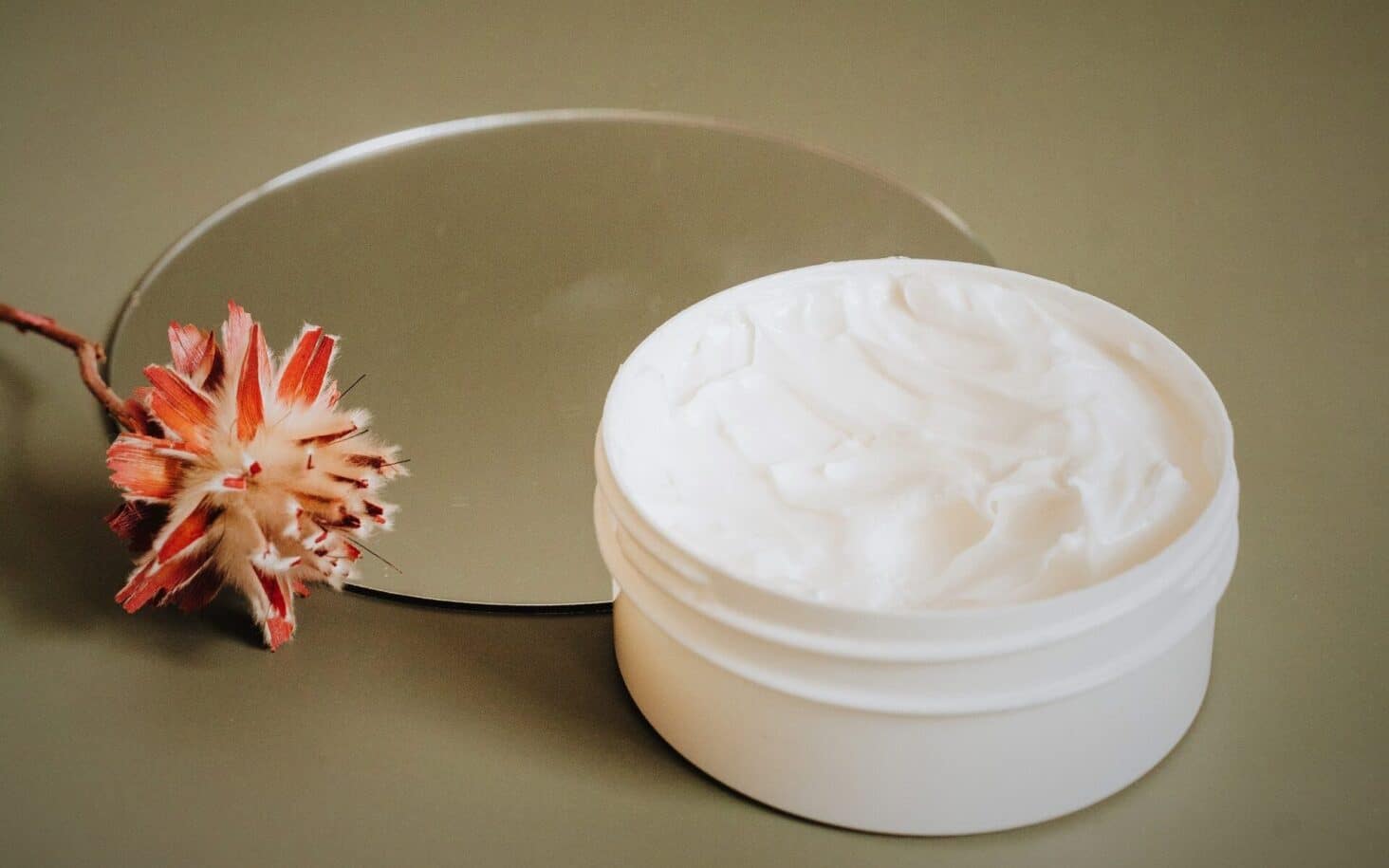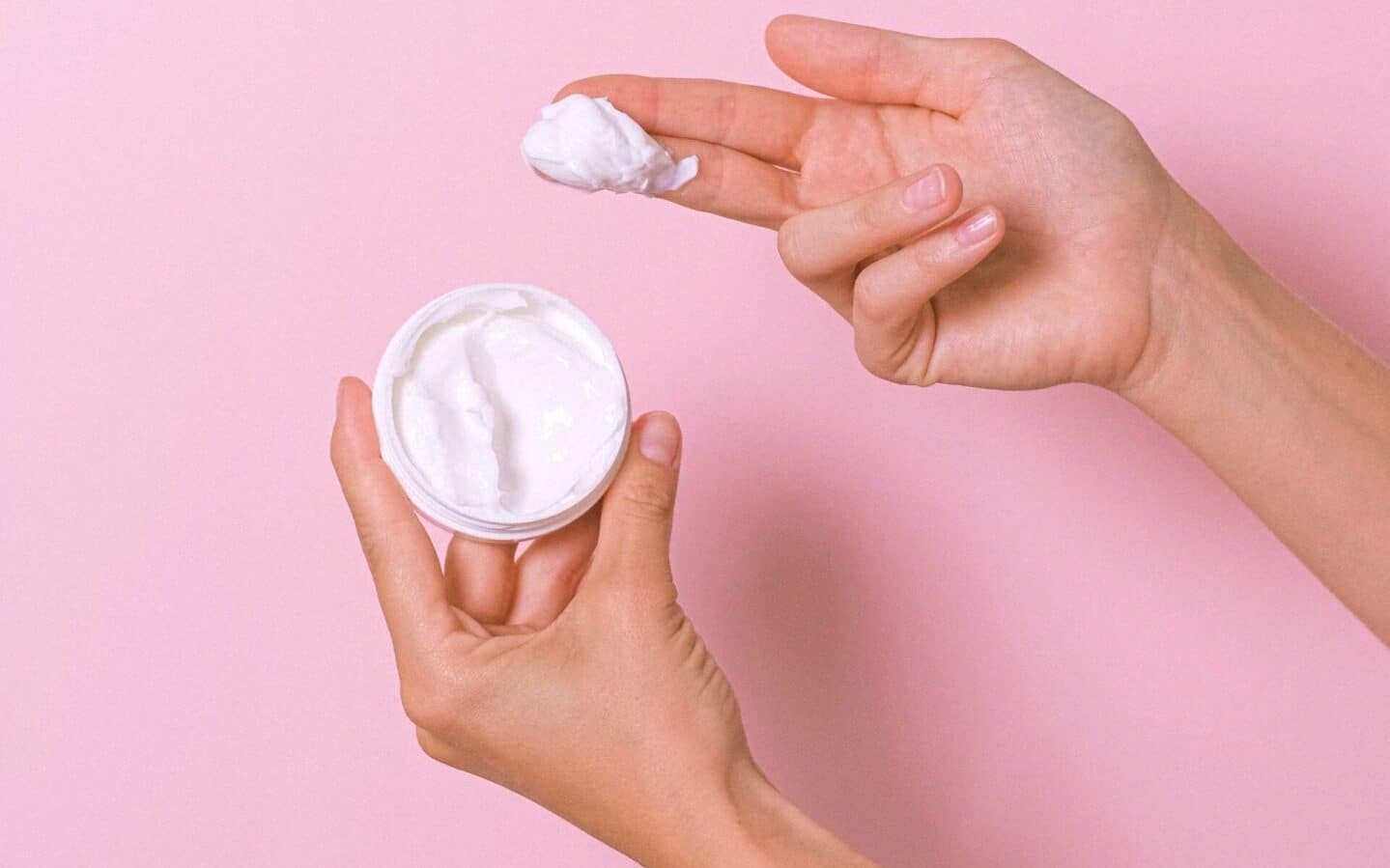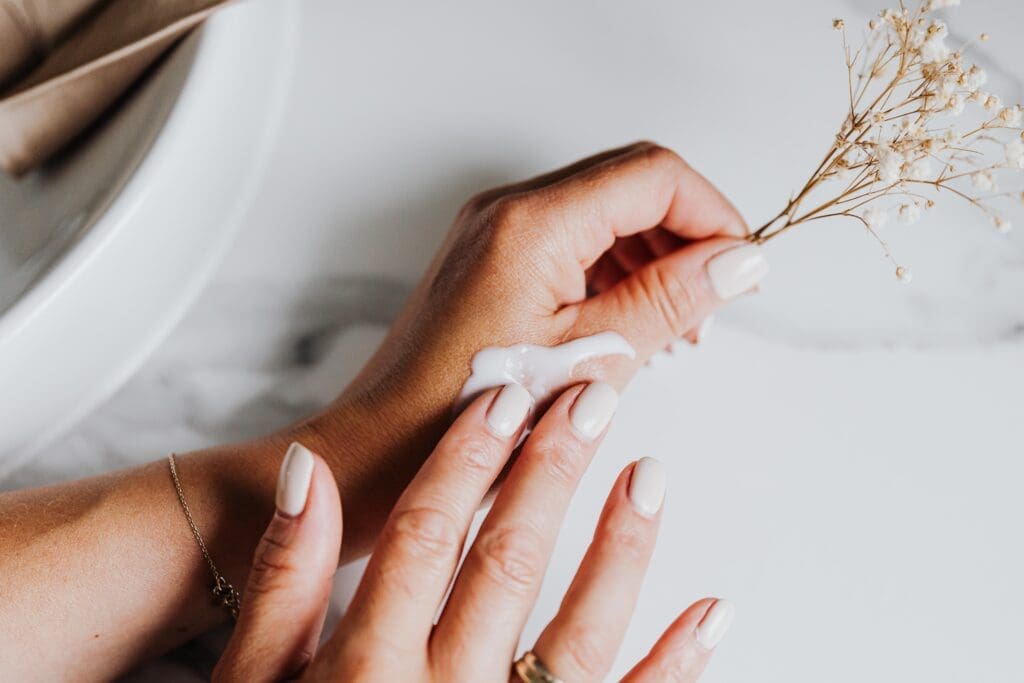What’s In Your Lotion?

Lotions come in a wide variety of types and serve various functions. Whether used for soothing cracked, dry hands or moisturizing the body after a bath or shower, lotions hydrate and soften the skin and often have a pleasing fragrance. Their texture is generally less viscous than creams or gels, making for easier application to the skin. Some lotions even contain antibiotics, antifungals, anti-aging, and anti-acne ingredients depending on their purpose. Most of us have used lotion our whole lives and never stopped to think about what’s actually in the bottle. So what is lotion made of, and what exactly are we putting on our skin?
What is lotion made of?
Body lotions typically contain a combination of moisturizing agents, emollients, humectants, and sometimes additional active ingredients for specific skin concerns. The cosmetic industry has rapidly expanded the options around botanical extracts and various natural or naturally derived ingredients that provide unique sensorial experiences for skincare products.
What are the main ingredients in body lotion?
- Water: Acting as a solvent and base for other ingredients, water is typically the highest concentration ingredient found in body lotions.
- Emollients, Humectants, Occlusives: Ingredients such as Shea Butter, Cocoa Butter, Jojoba Oil soften and smooth the skin by forming a protective layer that traps moisture. Glycerin, honey, and aloe vera are examples of humectants, which attract the skin and help maintain hydration. Beeswax, lanolin, and coconut oil help seal moisture into the skin by forming a barrier on its surface.
- Plant Extracts, Fragrance, Additional Active Ingredients: Plant extracts such as Green Tea Extract, Chamomile Extract, and Lavender Oil can provide additional benefits such as soothing properties, antioxidant protection, or fragrance. Fragrance is often desired to provide a pleasing scent and can come from essential oils or botanical extracts - or can have synthetic origins. Depending on the formulation, body lotions may contain specific actives to target various skin concerns such as aging, acne, or hyperpigmentation. Such actives include Niacinamide (Vitamin B3), Alpha Hydroxy Acids (found in fruits), and Tea Tree Oil.
- Emulsifying and Thickening Ingredients: While there are many synthetic emulsifiers and thickeners on the market, natural skincare formulators turn to ingredients such as beeswax, xanthan gum, cetyl alcohol, stearic acid, and lecithin to create beautiful body lotion emulsions. You might see ingredients such as cetearyl olivate, sorbitan olivate, glyceryl stearate, cetearyl alcohol, etc., but don't be alarmed by their "chemical" sounding name - these are all natural or naturally derived and safe for your skin!
- Vitamins, Antioxidants, Preservatives: Vitamin E (tocopherol), Vitamin C (ascorbic acid), and Rosehip Oil (rich in Vitamin A) are commonly found in lotions and help nourish and protect the skin. There is a misperception that certain antioxidants - grapefruit seed extract, vitamin E, rosemary extract - protect a product. While these certainly are beneficial for the skin and extend the shelf life by preventing rancidity in butters and oils, they do not protect a lotion from microbial growth - bacteria, fungus, mold. A preservation system is imperative in products that contain water or come in contact with water. Preservatives have been a controversial topic among consumers, but nothing is scarier than a product NOT adequately preserved and protected! Luckily, the cosmetic industry has expanded the options available to naturally and safely preserve skincare products.

What Should Not Be in a Body Lotion?
There are a number of ingredients that could be in your lotion that you don’t want in your lotion. It's important to avoid certain ingredients that may be harmful or irritating to the skin. Here are a few ingredients commonly avoided in lotion:
- Mineral Oil, Silicones: A petroleum-derived ingredient, mineral oil can clog pores and may interfere with the skin's natural functions. Silicones, while not necessarily harmful, can form a barrier on the skin that may trap debris and impurities, leading to potential breakouts.
- Synthetic Fragrances, Synthetic Colors: Artificial fragrances can contain a mix of potentially harmful chemicals, including allergens and sensitizers. Artificial colors may be derived from coal tar or other chemicals and can cause skin irritation or sensitivity. Brands are to include known allergens on product labels if allergens exist over a certain level. So, check your labels!
- Phthalates show up in lotions and other cosmetic products as binding agents. Often used as fragrance ingredients or plasticizers, phthalates may disrupt hormone function and have been associated with reproductive issues. Unfortunately, they’ve also been linked to problems of the neurological, respiratory, and behavioral systems. It’s better to be on the safe side and avoid products that contain phthalates.
- Formaldehyde and Formaldehyde Releasers: These chemicals, which help prevent microbes from growing in water-based products, can be absorbed through the skin and have been linked to cancer and allergic skin reactions. Examples include imidazolidinyl urea, diazolidinyl urea, and polyoxymethylene urea.
- Triclosan: An antimicrobial agent commonly found in personal care products, triclosan has been linked to hormone disruption and antibiotic resistance.
- Ethanolamines (DEA, TEA, MEA): These compounds can react with other ingredients to form potentially harmful nitrosamines, which are carcinogenic.
- Parabens are synthetic compounds used as a preservative in products ranging from pharmaceuticals, foods, toothpastes, cosmetics, and yes, lotions. Parabens have caught much adverse attention among consumers, and although these preservatives are highly effective in very minimal quantities, the main concern is the cumulative exposure to the chemicals from several different products. Albeit these are FDA-approved preservatives, suppliers have focused on manufacturing paraben-free alternatives that are just as effective in preventing microbial growth in personal care products.

What Should Be in a Body Lotion?
Ideally, a lotion should contain ingredients mentioned above that help it serve its purpose of healing, hydrating, and nourishing the skin while being safe to use (and hopefully smelling nice too!). Being "safe to use" means proper preservation to prevent harmful contamination and microbial growth.
Taboodoir has dedicated much time to research the options available and uses broad-spectrum preservatives that are approved for natural skincare formulation. Our preservatives are paraben-free and formaldehyde-free and provide optimized protection against potential bacteria, mold, and yeast. We also use natural ingredients that offer proven benefits to the skin—ingredients like grapefruit seed extract and rosemary oils (that have antimicrobial properties) and Shea butter (that is known for its moisturizing and antioxidant effects).
Hopefully this guide helps you understand a bit more about those unrecognizable ingredients in your lotion. And as always, if you have any questions about an ingredient in any of our Taboodoir products, don’t hesitate to reach out and ask!
Disclaimer:
The content provided here is for informational purposes only. This blog is not intended to substitute for medical advice, diagnosis, or treatment. Always seek the advice of a qualified healthcare provider for any questions or concerns you may have regarding a medical condition.
What’s In Your Lotion?

Lotions come in a wide variety of types and serve various functions. Whether used for soothing cracked, dry hands or moisturizing the body after a bath or shower, lotions hydrate and soften the skin and often have a pleasing fragrance. Their texture is generally less viscous than creams or gels, making for easier application to the skin. Some lotions even contain antibiotics, antifungals, anti-aging, and anti-acne ingredients depending on their purpose. Most of us have used lotion our whole lives and never stopped to think about what’s actually in the bottle. So what is lotion made of, and what exactly are we putting on our skin?
What is lotion made of?
Body lotions typically contain a combination of moisturizing agents, emollients, humectants, and sometimes additional active ingredients for specific skin concerns. The cosmetic industry has rapidly expanded the options around botanical extracts and various natural or naturally derived ingredients that provide unique sensorial experiences for skincare products.
What are the main ingredients in body lotion?
- Water: Acting as a solvent and base for other ingredients, water is typically the highest concentration ingredient found in body lotions.
- Emollients, Humectants, Occlusives: Ingredients such as Shea Butter, Cocoa Butter, Jojoba Oil soften and smooth the skin by forming a protective layer that traps moisture. Glycerin, honey, and aloe vera are examples of humectants, which attract the skin and help maintain hydration. Beeswax, lanolin, and coconut oil help seal moisture into the skin by forming a barrier on its surface.
- Plant Extracts, Fragrance, Additional Active Ingredients: Plant extracts such as Green Tea Extract, Chamomile Extract, and Lavender Oil can provide additional benefits such as soothing properties, antioxidant protection, or fragrance. Fragrance is often desired to provide a pleasing scent and can come from essential oils or botanical extracts - or can have synthetic origins. Depending on the formulation, body lotions may contain specific actives to target various skin concerns such as aging, acne, or hyperpigmentation. Such actives include Niacinamide (Vitamin B3), Alpha Hydroxy Acids (found in fruits), and Tea Tree Oil.
- Emulsifying and Thickening Ingredients: While there are many synthetic emulsifiers and thickeners on the market, natural skincare formulators turn to ingredients such as beeswax, xanthan gum, cetyl alcohol, stearic acid, and lecithin to create beautiful body lotion emulsions. You might see ingredients such as cetearyl olivate, sorbitan olivate, glyceryl stearate, cetearyl alcohol, etc., but don't be alarmed by their "chemical" sounding name - these are all natural or naturally derived and safe for your skin!
- Vitamins, Antioxidants, Preservatives: Vitamin E (tocopherol), Vitamin C (ascorbic acid), and Rosehip Oil (rich in Vitamin A) are commonly found in lotions and help nourish and protect the skin. There is a misperception that certain antioxidants - grapefruit seed extract, vitamin E, rosemary extract - protect a product. While these certainly are beneficial for the skin and extend the shelf life by preventing rancidity in butters and oils, they do not protect a lotion from microbial growth - bacteria, fungus, mold. A preservation system is imperative in products that contain water or come in contact with water. Preservatives have been a controversial topic among consumers, but nothing is scarier than a product NOT adequately preserved and protected! Luckily, the cosmetic industry has expanded the options available to naturally and safely preserve skincare products.

What Should Not Be in a Body Lotion?
There are a number of ingredients that could be in your lotion that you don’t want in your lotion. It's important to avoid certain ingredients that may be harmful or irritating to the skin. Here are a few ingredients commonly avoided in lotion:
- Mineral Oil, Silicones: A petroleum-derived ingredient, mineral oil can clog pores and may interfere with the skin's natural functions. Silicones, while not necessarily harmful, can form a barrier on the skin that may trap debris and impurities, leading to potential breakouts.
- Synthetic Fragrances, Synthetic Colors: Artificial fragrances can contain a mix of potentially harmful chemicals, including allergens and sensitizers. Artificial colors may be derived from coal tar or other chemicals and can cause skin irritation or sensitivity. Brands are to include known allergens on product labels if allergens exist over a certain level. So, check your labels!
- Phthalates show up in lotions and other cosmetic products as binding agents. Often used as fragrance ingredients or plasticizers, phthalates may disrupt hormone function and have been associated with reproductive issues. Unfortunately, they’ve also been linked to problems of the neurological, respiratory, and behavioral systems. It’s better to be on the safe side and avoid products that contain phthalates.
- Formaldehyde and Formaldehyde Releasers: These chemicals, which help prevent microbes from growing in water-based products, can be absorbed through the skin and have been linked to cancer and allergic skin reactions. Examples include imidazolidinyl urea, diazolidinyl urea, and polyoxymethylene urea.
- Triclosan: An antimicrobial agent commonly found in personal care products, triclosan has been linked to hormone disruption and antibiotic resistance.
- Ethanolamines (DEA, TEA, MEA): These compounds can react with other ingredients to form potentially harmful nitrosamines, which are carcinogenic.
- Parabens are synthetic compounds used as a preservative in products ranging from pharmaceuticals, foods, toothpastes, cosmetics, and yes, lotions. Parabens have caught much adverse attention among consumers, and although these preservatives are highly effective in very minimal quantities, the main concern is the cumulative exposure to the chemicals from several different products. Albeit these are FDA-approved preservatives, suppliers have focused on manufacturing paraben-free alternatives that are just as effective in preventing microbial growth in personal care products.

What Should Be in a Body Lotion?
Ideally, a lotion should contain ingredients mentioned above that help it serve its purpose of healing, hydrating, and nourishing the skin while being safe to use (and hopefully smelling nice too!). Being "safe to use" means proper preservation to prevent harmful contamination and microbial growth.
Taboodoir has dedicated much time to research the options available and uses broad-spectrum preservatives that are approved for natural skincare formulation. Our preservatives are paraben-free and formaldehyde-free and provide optimized protection against potential bacteria, mold, and yeast. We also use natural ingredients that offer proven benefits to the skin—ingredients like grapefruit seed extract and rosemary oils (that have antimicrobial properties) and Shea butter (that is known for its moisturizing and antioxidant effects).
Hopefully this guide helps you understand a bit more about those unrecognizable ingredients in your lotion. And as always, if you have any questions about an ingredient in any of our Taboodoir products, don’t hesitate to reach out and ask!
Disclaimer:
The content provided here is for informational purposes only. This blog is not intended to substitute for medical advice, diagnosis, or treatment. Always seek the advice of a qualified healthcare provider for any questions or concerns you may have regarding a medical condition.
